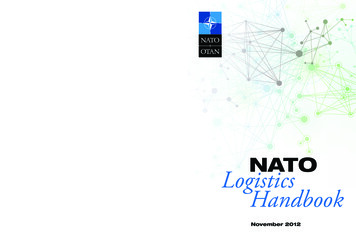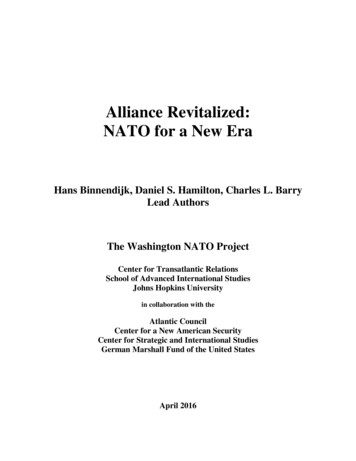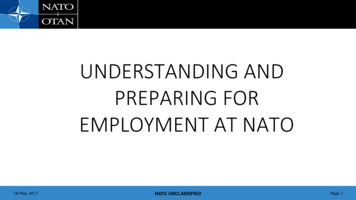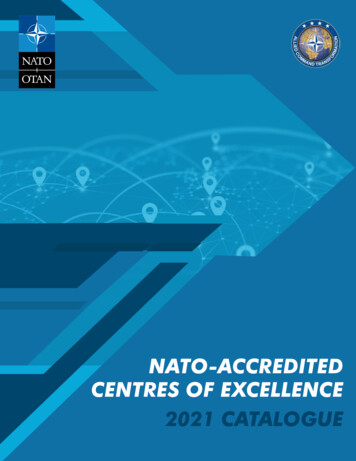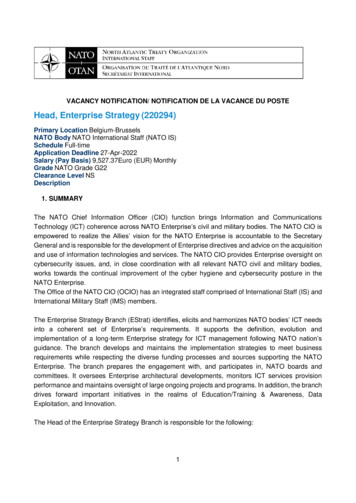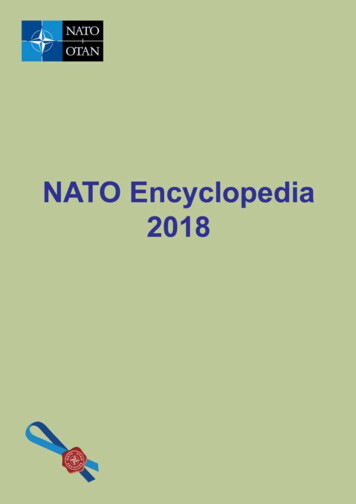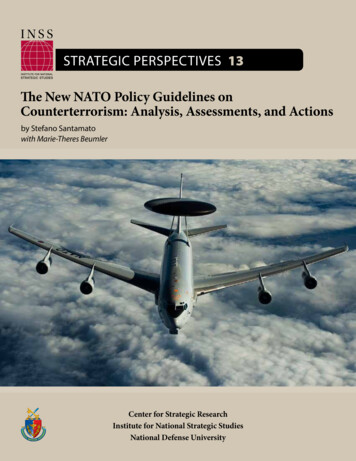
Transcription
Strategic Perspectives 13The New NATO Policy Guidelines onCounterterrorism: Analysis, Assessments, and Actionsby Stefano Santamatowith Marie-Theres BeumlerCenter for Strategic ResearchInstitute for National Strategic StudiesNational Defense University
Institute for National Strategic StudiesNational Defense UniversityThe Institute for National Strategic Studies (INSS) is NationalDefense University’s (NDU’s) dedicated research arm. INSS includesthe Center for Strategic Research, Center for Complex Operations,Center for the Study of Chinese Military Affairs, Center forTechnology and National Security Policy, and Conflict RecordsResearch Center. The military and civilian analysts and staff whocomprise INSS and its subcomponents execute their mission byconducting research and analysis, publishing, and participating inconferences, policy support, and outreach.The mission of INSS is to conduct strategic studies for the Secretaryof Defense, Chairman of the Joint Chiefs of Staff, and the UnifiedCombatant Commands in support of the academic programs at NDUand to perform outreach to other U.S. Government agencies and thebroader national security community.Cover: NATO E-3A Sentry Airborne Warning and Control System (AWACS)aircraft flies mission over southern Germany, September 2012.On October 8, 2001, NATO launched its first antiterror operation,Eagle Assist, whereby AWACS aircraft were sent to help patrolthe skies over the United States for 8 months.Photo by Bennie J. Davis III (U.S. Air Force)
The New NATO Policy Guidelines onCounterterrorism
The New NATO Policy Guidelines onCounterterrorism: Analysis,Assessment, and ActionsBy Stefano Santamatowith Marie-Theres BeumlerInstitute for National Strategic StudiesStrategic Perspectives, No. 13Series Editor: Nicholas RostowNational Defense University PressWashington, D.C.February 2013
Opinions, conclusions, and recommendations expressed or implied within are solely thoseof the contributors and do not necessarily represent the views of the Defense Department or anyother agency of the Federal Government. Cleared for public release; distribution unlimited.Portions of this work may be quoted or reprinted without permission, provided that astandard source credit line is included. NDU Press would appreciate a courtesy copy of reprintsor reviews.First printing, February 2013For current publications of the Institute for National Strategic Studies, please go to theNational Defense University Web site at: www.ndu.edu/inss.
ContentsExecutive Summary.1Introduction.3Evolution of the Transnational Terrorist Threat.4NATO’s Response.7The New NATO Policy Guidelines on Counterterrorism.9Conclusion.25Appendix A. NATO’s Policy Guidelines on Counter-terrorism—Aware, Capable and Engaged for a Safer Future (May 21, 2012).27Appendix B. Overview of National and International Response.31Appendix C. Key NATO Documents.36Notes.39About the Authors.47
The New NATO Policy Guidelines on CounterterrorismExecutive SummaryThe history of the North Atlantic Treaty Organization (NATO) will say that the first, and sofar only, time NATO has called upon its Article 5 collective defense clause was on September 12,2001, following a terrorist attack on one of its members. Yet, until the agreement by NATO Headsof State and Government on the new policy guidelines on counterterrorism on May 20, 2012,NATO did not have an agreed policy to define its role and mandate in countering terrorism.In the 11 years that have followed the 9/11 attacks on the United States, NATO has optedfor a pragmatic approach to the fight against terrorism and succeeded in identifying its addedvalue. The result has been a series of substantial counterterrorism activities. Their impact, however, has been mitigated by the lack of an agreed policy defining NATO’s rightful place amonginternational counterterrorism actors. The evolving nature of the terrorist environment and ofthe global responses required has made it necessary to reassess the threat posed by terrorismand its implications for the Alliance. The new NATO policy guidelines on counterterrorismare the result of a comprehensive intellectual and political process that started with the 2010Strategic Concept and led to the conclusion that in an era in which emerging challenges blendcollective defense with the broader concept of collective security, the lens of collective interestmust replace the prism of national perspectives. With this in mind, the overall judgment on thenew policy guidelines can and should be positive.Conceptually, the guidelines translate the notions of prevention and resilience into NATOpolicy and anchor its counterterrorism activities to the Alliance’s core tasks of collective defense,crisis management, and cooperative security.In substance, the new policy guidelines focus on NATO’s strengths, such as intelligencesharing, capacity-building, special operations forces, training, and technology and capabilities.In doing so, the guidelines inaugurate a new phase of NATO’s engagement in countering terrorism, predicated around the three principles of compliance with international law, NATOsupport to Allies, and nonduplication and complementarity in addition to focusing on the threekey areas of awareness, capabilities, and engagement.There are, however, three persisting shadow areas that may hinder the policy’s potential.One is the vague and qualified notion of NATO cooperation with the European Union. Thesecond is the need to reconcile the horizontal and cross-cutting nature of the terrorist threatwith the vertical reality of Alliance policies and structures. The third area is the need to establisha clearer and more direct link between NATO’s broader efforts and Allies’ homeland security,intended here as the fundamental bond between sovereignty and the body public.1
Strategic Perspectives, No. 13In this respect, the guidelines represent only a necessary first step. The challenge ahead forNATO policymakers is to define an Action Plan that ensures the implementation of the policyguidelines while, and by, addressing these issues. To this end, this paper suggests six crosscutting proposals that should find their way into the proposed Action Plan: apply “Net Assessment” to counterterrorism develop effective counterterrorism strategic communications establish a homeland security constituency in NATO and foster the executive role of theTerrorism Task Force promote a NATO Border Security Initiative develop a “functional” Counterterrorism Partnership Framework contribute to the Global Counterterrorism Forum.While certainly not sufficient, these six initiatives may well be necessary conditions to helpplace counterterrorism at the center of NATO’s post–International Security Assistance Forceagenda and offer a new template for NATO’s role in facing the emerging security environmentin an unpredictable world.2
The New NATO Policy Guidelines on CounterterrorismIntroductionIn April 2012, the North Atlantic Council agreed on the new North Atlantic TreatyOrganization (NATO) policy guidelines on counterterrorism. On May 20, 2012, the Alliance’s Heads of State and Government endorsed the policy guidelines at their summit inChicago and tasked the North Atlantic Council to “prepare an Action Plan to further enhance NATO’s ability to prevent, deter, and respond to terrorism by identifying initiativesto enhance threat awareness, capabilities, and engagement.”1What may appear as routine NATO business—the agreement of a policy and the development of an implementation plan—is in fact groundbreaking news for the Alliance. Until now,NATO did not have an agreed policy to define its role and mandate in countering the terroristthreat, notwithstanding the fact that a terrorist attack was the origin of its first and only invocation of the Article 5 collective defense clause.In the 11 years that followed the 9/11 attacks on the United States, NATO opted for a pragmatic approach to its contribution to the fight against terrorism, aware of the political, historical, and sometimes ideological differences among Allies. On the ground, NATO’s contributionhas been substantial; the Alliance has engaged in all areas of work related to terrorism—political, operational, conceptual, military, technological, and scientific. Yet the evolving nature of theterrorist environment, and of the global response, has made it necessary to reassess the threatposed by terrorism and its implications for the Alliance.This trend was first captured by the new Strategic Concept, adopted by NATO Heads ofState and Government at the Alliance’s Lisbon Summit in November 2010. For the first time,terrorism was specifically included among the direct threats to NATO’s security and a renewedemphasis placed on the Alliance’s role in fighting it.2 By focusing on threat analysis, partnerconsultations, capability development, and training, the Strategic Concept also indicated theway ahead. Against these premises, the Allied nations acknowledged the need to reinvigorateNATO’s role in, and contribution to, the fight against terrorism.The new NATO policy guidelines on counterterrorism are the result of a comprehensiveintellectual and political process that started with the 2010 Strategic Concept, passed throughthe analysis of the evolving terrorist environment, and ended with an assessment of NATO’scontribution to the fight against terrorism. In this respect, the guidelines should not be considered as the snapshot of an endstate but rather as a fresh start for a contribution to counteringterrorism. The development of an Action Plan on counterterrorism will translate policy intoaction and provide answers to questions left open.3
Strategic Perspectives, No. 13The logical deduction of this process is that against the evolving nature of an increasinglyglobal and interconnected terrorist threat, an “across the board” approach to fighting terroristnetworks becomes both sensible and necessary. Broad international counterterrorist alliancesbecome part of the solution. Defining NATO’s own role in countering terrorism becomes acompelling need.Evolution of the Transnational Terrorist ThreatToday, terrorism has become more dispersed, decentralized, and multifaceted. In a word,it has become complex. One can adopt a “methods and motives”3 approach or attempt to makea distinction between national and international terrorism and still not be able to define a singleframework to capture all aspects of the challenge. As a direct consequence of al Qaeda’s attackson the United States, NATO’s involvement with countering terrorism has focused on its international dimension “over and above” national efforts and beyond national borders.Well before the demise of Osama bin Laden in May 2011, experts concurred that therewas no longer a wide global network run directly by al Qaeda. Thanks also to the successesin disrupting its leadership and network, al Qaeda–like operations are increasingly dependenton local “franchises,” such as in Yemen, Somalia, the Middle East, and North Africa.4 Whilepotentially diminishing the scope and reach of al Qaeda’s activity, this evolution cannot be considered a strategic victory. A scattered al Qaeda network becomes more difficult to pin down.Its leadership decreases in influence but spreads in numbers. Front lines become more blurredand terrorist tactics diversify and blend. Terrorism becomes a principal tactic incorporated bystates and nonstate actors within a “new” category of “hybrid” threats.5On the operational and tactical side, five interconnected trends confirm an evolution ofthe terrorists’ strategy and modus operandi: the established connection between terrorist organizations, insurgent groups, and international organized crime; the emergence of homegrownterrorists and “lone wolves”; reliance on complex funding mechanisms; use of sophisticatedpropaganda; and access to advanced technologies and fascination with unconventional highimpact operations.While not an absolute first in terrorism history, the growing nexus among terrorist organizations, insurgents, and international crime is possibly the starkest reminder that national andinternational actors cannot deal with terrorism in watertight compartments.6Military and law enforcement operations become part of a continuum in the counterterrorism response. In some cases, terrorist and illegal activities merge to finance their organizations’ operations.7 Specifically, the link between terrorist entities and drug trafficking is4
The New NATO Policy Guidelines on Counterterrorisma well-known concern, with connections stretching from South America to West and NorthAfrica, Europe, the Balkans, Central Asia, and Afghanistan.8 Among others, these activities andconnections give terrorists wider autonomy, making them less dependent on “external” supportfrom sponsor nations, reducing the reach and leverage of any international response.Besides financial support, it is the operational cooperation between these various criminal organizations that is most worrisome. Training, experience, and lessons learned are oftenshared between these groups to improve tactics, techniques, and materiel.9 This phenomenon isparticularly present in so called ungoverned spaces,10 which are used by nonstate actors to establish training camps to pursue indoctrination and develop operational capacity. Ungovernedor undergoverned spaces attract criminal groups, insurgents, and terrorists alike, and statesharboring such territories are either unwilling or unable to disrupt or interfere with the groups’activities, albeit claiming sovereignty before international law. The exploitation of this “sovereignty gap” poses increasing threats to the international community due to rapidly developingcommunications and travel patterns, as the history of Afghanistan under Taliban rule mostinfamously proves.In the last 5 years, another growing concern has been the emergence of homegrown terrorists. In the words of Lucio Caracciolo, “terrorists don’t have to come to us. They already areamong us.”11 Homegrown terrorists may range from lone-wolf individuals to “self-recruited,self-trained, and self-executing” groups with few or no connections to an international conspiracy, to groups living in a particular country who have trained with and maintained connectionsto the al Qaeda network, and finally to al Qaeda “sleeper cells” aiming to conduct medium- orlong-term actions in a particular country.12Homegrown terrorists are difficult to identify, detect, and stop. The fact that they engagein suicide attacks is a matter of greater concern to national governments.13 Their threat is comparatively low, but their impact on the public psyche is high.14 Through isolated, unrelated,low technology, and low-cost actions, terrorists achieve devastating societal effects well beyondtheir immediate victims.15 Stressed neighborhoods lose confidence in the very authorities incharge of their protection, the rhetoric becomes polarized, and escalating resentment fuels terrorist recruitment.16In terms of finance, the growing nexus between terrorism and organized crime offers terrorist entities new and alternative financing opportunities.17 While remarkable results havebeen achieved in countering terrorism funding thanks to increased bilateral and multinationalcooperation of law enforcement agencies and organizations,18 the suppression of funding channels traceable to terrorist groups remains particularly difficult due to their constant technical5
Strategic Perspectives, No. 13evolution and dissemination.19 In recent years, income deriving from smuggling, money laundering, and human trafficking has grown steadily, and kidnapping of foreigners has become oneof the most lucrative funding sources for international terrorists.In parallel, to face the national and international response and maintain support and recruitment, the volume and sophistication of al Qaeda’s communications have increased. Thereare now thousands of Web sites, in many languages, devoted to “virtual proselytism.” Terroristgroups have abandoned old tape or DVD production and dissemination and turned to the useof the Internet to radicalize their followers around the globe and instruct them on the means ofviolence.20This extensive use of the Internet has led counterterrorism experts to consider al Qaedaand its affiliates as primary “customers” of Web forums and social media, and therefore not keento engage in disruptive actions that could affect their own ability to reach out to members andrecruits. However, as technology is evolving and becoming more available, the terrorist threatto cyber space is also increasing. In a video presented by the Federal Bureau of Investigationto the U.S. Senate Committee on Homeland Security and Governmental Affairs, al Qaeda callsfor an “electronic jihad,” urging “covert mujahidin” to launch cyber attacks against Americancritical infrastructure.21The renewed interest in cyber-terrorist activities is consistent with al Qaeda’s use of, andfascination with, high-impact operations. In this respect, al Qaeda’s longstanding interest inacquiring weapons of mass destruction (WMDs), specifically of a chemical, biological, radiological, and nuclear (CBRN) nature, is also well known. So far, the efforts of terrorist groups toacquire or use these weapons and materials have been sporadic and mostly unsuccessful.22 Forthe foreseeable future, militant jihadist groups will only be able to produce rudimentary radiological weapons (that is, “dirty bombs”) that would cause great panic and disruption but onlylimited casualties. However, even if the use of WMDs remains confined to the high end of thethreat spectrum, in the words of Harold Agnew, “If you believe that it is easy to make an improvised nuclear weapon, you are wrong. But if you believe it is impossible for a terrorist group tomake an improvised nuclear bomb, you are dead.”23With terrorism becoming increasingly globalized and hybrid, unity of effort and comprehensive approaches become the key paradigms for all counterterrorism actors. Put differently, global terrorist networks take advantage of national and international legal loopholesand operational gray areas. In a field as dynamic as counterterrorism, the lens of collectiveinterest must replace the prism of national perspectives. Efforts should be joined in mutuallyreinforcing ways, beyond political entrenchments and doctrinal boundaries. In the decade-plus6
The New NATO Policy Guidelines on Counterterrorismthat followed the 9/11 attacks, NATO proved its ability to contribute to the global fight againstterror. Mindful of its assets and mandates, NATO has succeeded in identifying its added valueto specific aspects of the terrorism challenge. The result has been a series of substantial counterterrorism activities whose impact, however, has been mitigated by the lack of an agreed policydefining NATO’s rightful place among international counterterrorism actors.NATO’s ResponseAt the core of NATO’s reticence in codifying its decade-long contribution to the fightagainst terrorism in an agreed policy lies a definition challenge. The incidence, nature, scope,and, above all, perception of the threat posed by terrorists vary enormously among countriesand regions.24 To provide a common definition of what constitutes a terrorist is an exercise ofdrafting acrobatics, impossible even for the most skilled and experienced NATO policymaker.Yet the very nature of NATO—a political-military organization for the collective defenseof its members’ territories and populations from external attacks—drives its need to identifywhere an attack is coming from and who the enemy is. In the case of the fight against terrorism,the Alliance instinctively needs to define who and where the terrorists actually are. Terrorism,like war, is ultimately a means to an end, not an end per se. For many years, in the collectivepsyche of NATO’s integrated structure, to fight against terrorism without identifying the adversary was like fighting war itself. The lack of a clear opponent denied planners and diplomatsa critical element of NATO’s defense paradigm. Consistent with this logic, the 1999 StrategicConcept made only indirect reference to acts of terrorism as one of many security challengesand risks together with sabotage, organized crime, and the disruption of the flow of vital resources.25 On the other hand, the nature of terrorist acts has long been perceived, especiallyin Europe, as deriving from “internal” motives—from separatism to political extremism andanarchism.It is therefore not surprising that, beyond its solidarity significance, at the basis of NATO’sArticle 5 invocation following the 9/11 attacks was the determination that the strikes were directed from abroad. Al Qaeda’s claim of responsibility and the Taliban regime’s refusal to handover Osama bin Laden to U.S. authorities provided incarnation and direction to the global terrorist threat.This acted as a potent catalyst for NATO’s contribution to the global fight against terrorism. However, NATO has preferred to avoid a potentially loaded political debate on its rolein counterterrorism, opting for a more pragmatic approach. Through its operational commitments—first and foremost in Afghanistan but also in the Mediterranean Sea, in the Indian7
Strategic Perspectives, No. 13Ocean and, not to be overlooked, in protecting high-visibility events such as the Greek OlympicGames in 2004 and the NATO summit in Riga in 200626—NATO has accumulated considerable cross-cutting experience in counterterrorism, counterinsurgency, intelligence-sharing, andtechnology development.In 2001, NATO launched its first ever antiterror operation—Eagle Assist, whereby NATOAWACS (airborne warning and control system) aircraft were sent to help patrol the skies overthe United States for 8 months. In 2002, the Alliance launched its second counterterrorism operation, Active Endeavour, which is ongoing. In May 2002, NATO foreign ministers decided attheir meeting in Reykjavik that the Alliance would operate when and where necessary to fightterrorism, therefore settling the out-of-area debate and paving the way for future engagementswith the International Security Assistance Force (ISAF) in Afghanistan.Action on the ground was accompanied by capacity initiatives. At the Alliance’s 2002Prague Summit, Heads of State and Government adopted a package aimed at adapting NATO tothe challenge of terrorism and including the following: a Military Concept for Defense againstTerrorism;27 a Partnership Action Plan against Terrorism (PAP-T); five nuclear, biological, andchemical defense initiatives; protection of civilian populations including a Civil-EmergencyPlanning Action Plan; the NATO Response Force; and the Prague Capabilities Commitment.At the 2004 Istanbul Summit, the Allies endorsed the creation of the Defense Against Terrorism(DAT) Program of Work (POW) to improve the response to new security challenges posed byasymmetric threats. Intelligence-sharing was enhanced including through the establishment ofa Terrorist Threat Intelligence Unit, which became part of the new intelligence structure thatwas set up as part of NATO’s ongoing intelligence reform efforts.Meanwhile, the increasing complexity and inevitable realization that the fight againstglobal terror was a long-term struggle pushed NATO policymakers to look at terrorism from adifferent perspective.In endorsing the Comprehensive Political Guidance at the Riga Summit in November 2006,NATO recognized that “terrorism . . . and the spread of weapons of mass destruction are likelyto be the principal threats to the Alliance over the next 10 to 15 years.”28 With the 2010 StrategicConcept agreed at Lisbon in November 2010, NATO has completed its intellectual and politicalevolution vis-à-vis the terrorist threat. Terrorism is no longer an operational or tactical dimension of asymmetric warfare; it has become a “direct threat to the citizens of NATO countriesand to international stability and prosperity, more broadly.”29 Collective defense blends with thebroader concept of collective security, opening new perspectives for NATO in the fight againstterrorism and placing new emphasis on the need to define the Alliance’s role and contribution.8
The New NATO Policy Guidelines on CounterterrorismThe New NATO Policy Guidelines on CounterterrorismAt the basis of the policy guidelines rests the clear mandate from the Lisbon Summit. Theguidelines reiterate the Strategic Concept statement that terrorism constitutes a direct threatto the security of the citizens of NATO countries and to international stability and prosperitymore broadly and that it will remain a threat in the Allies’ territory as well as in areas of strategicimportance to NATO.30In terms of NATO’s role in counterterrorism, the guidelines implicitly acknowledge theabsence of a specific policy since NATO’s post-9/11 engagement in the global fight against terrorism, while claiming NATO’s significant contribution.31The guidelines place an accent on the danger that “conducive environments” present interms of the spread of terrorism and terrorist safe havens, extremist ideologies, intolerance,and fundamentalism. They also focus on terrorists’ use of conventional and unconventionalmeans, as well as on the risk of terrorist access to CBRN materials and weapons. In doing so,the guidelines manage to ably define their realm of application in terms of terrorist meansand center of gravity without entering into a controversial attempt to provide a shared definition of terrorism.The Good NewsAs the new guidelines unfold, describing and defining the operational framework in whichthe Alliance will develop its contribution to countering terrorism, they translate into policyNATO’s innovative approach to security introduced by the 2010 Strategic Concept.To begin with, the guidelines have the great merit of not shying away from the intrinsiccomplexity of dealing with the terrorist threat and recognize from the outset that the primaryresponsibility in countering terrorism rests with “civilian” law enforcement and judicial authorities. The key word in this respect is complementarity. With its new policy guidance, NATO accepts that its role in countering the threat complements, and is complemented by, the mandatesof other national and international organizations.32Another important aspect of the guidelines is the introduction of a broader concept ofcountering terrorism, through the inclusion of the notions of prevention and resilience.33 In enlarging the concept, the guidelines expand the extent of NATO’s contribution to countering terrorism, as defined by the Lisbon Summit Declaration, beyond deterrence, defense, disruption,and protection.34 This is also consistent with NATO’s approach to emerging security challenges,as introduced by the Alliance Cyber-Defense policy.359
Strategic Perspectives, No. 13Also worthy of notice is the inclusion, at the end of paragraph 4, of the guidelines’ goal toenable a more effective use of NATO resources through clear direction, enhanced coordination,and greater consistency of efforts. This reference is intended to meet the Strategic Concept’scommitment to “continuous reform towards a more effective, efficient and flexible Alliance, sothat our [NATO] taxpayers get the most security for the money they invest in defense.”36The stated aim of NATO’s Policy Guidelines on Counterterrorism is to move beyond amere restatement of the Strategic Concept and to avoid defining NATO’s role in counterterrorism in a way that may limit its contribution. The aim is to anchor NATO’s counterterrorismactivities to its stated core tasks of collective defense, crisis management, and collective security,thus reaffirming its ideological adherence to a comprehensive approach to crisis management.37This is an important aspect of the guidelines. As pointed out by Dr. Jamie Shea, NATO’s DeputyAssistant Secretary General for Emerging Security Challenges, “The Alliance has learned towork with the United Nations and its agencies on the ground to integrate civilian prioritiesinto military tasks [emphasis added].”38 The new policy guidelines on counterterrorism confirmNATO’s ambition to extend both the concept and the practice of its Comprehensive Approachto emerging security challenges.In terms of concept, the guidelines recognize civilian leadership in countering terrorism,thus inverting the Comprehensive Approach equation to focus on NATO’s value added to nonmilitary priorities.39 In practice, the guidelines’ aim is to focus not only on improved “awareness” of the threat and on providing “adequate capabilities” to address it, but also on “engaging”with other partners at the national or international level. To quote Dr. Shea again, in the future,“NATO’s military organization and capabilities . . . will need to be coordinated with domestic police, health, and emergency management agencies and organizations like the EuropeanUnion. So, NATO’s progress in practically embracing the new challenges will depend upon itscapacity for effective networking [emphasis added].”40Against these premises, the new approach of t
In April 2012, the North Atlantic Council agreed on the new North Atlantic Treaty Organization (NATO) policy guidelines on counterterrorism. On May 20, 2012, the Alli-ance's Heads of State and Government endorsed the policy guidelines at their summit in Chicago and tasked the North Atlantic Council to "prepare an Action Plan to further en-


